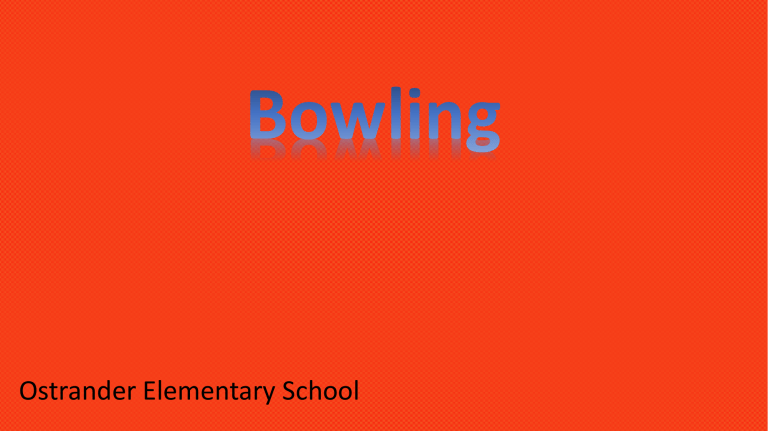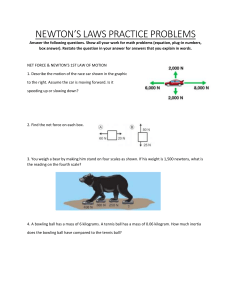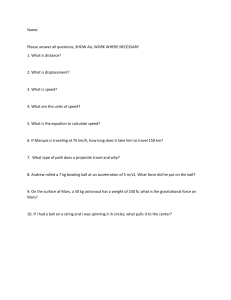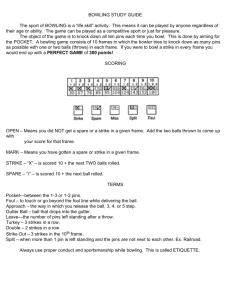
Ostrander Elementary School -Bowling has a long and rich history, and today it is one of the most popular sports in the world. -A British anthropologist, Sir Flinders Petrie, discovered in the 1930's a collection of objects in a child's grave in Egypt that appeared to him to be used for a crude form of bowling. -If he was correct, then bowling traces its ancestry to 3200 BC. -German historian, William Pehle, asserted that bowling began in his country about 300 AD -bowling was in vogue in England in 1366, when King Edward III allegedly outlawed it to keep his troops focused on archery practice In Vogue means -1841 Connecticut law made it illegal to maintain "any ninepin lanes,", probably because bowling was the object of much gambling. -Congress was for men. It was in 1917 that the Women's International Bowling Congress was born in St. Louis. - 1917 Bowling technology took a big step forward -Balls used to be primarily lignum vitae, a very hard wood. -But in 1905, the first rubber ball, the "Evertrue" was introduced -in 1914 the Brunswick Corporation successfully promoted the Mineralite ball, touting its "mysterious rubber compound.". -In 1951, another technological breakthrough set the stage for massive growth. American Machine and Foundry Company (AMF, then a maker of machinery for the bakery, tobacco and apparel businesses) purchased the patents to Gottfried Schmidt's automatic pinspotter, and by late 1952, production model pinspotters were introduced. No longer did a proprietor have to rely on "pinboys.". -Television embraced bowling in the 1950's, and the game's popularity grew exponentially. Today, the sport of bowling is enjoyed by 95 million people in more than 90 countries worldwide Bowling Terms: Address: Bowler’s starting position. Alley: playing surface, made of maple, pine or urethane boards; urethane lanes are becoming more popular than wood All the way: Finishing a game with nothing but strikes. Anchor: The last person to roll in a team competition. Approach: Part of the lane from the back of the ball return area to the foul line. Armswing: The arc of the bowling arm and hand from the first move toward the line until the delivery of the ball over the line. Baby ball: To throw too delicate or release too carefully. Ball rack: the rack used to store house balls or where the ball return rests balls before a turn. Ball return: Track between the lanes the ball rolls on when being returned to the rack. Bedposts: A 7-10 split. Curve: Ball that breaks from right to left. Cutter: A hook that slices the pins down. Delivery: Preparation, Release and Follow-through. Double: Two strikes in a row. Follow-through: The motion after release. Foul: Touching or going beyond the foul line. Foul line: The mark that determines the beginning of the lane Grandma¹s teeth: An array of pins left standing. Gutter: Drop offs about 10 inches wide to the right and the left of the lane to guide the ball to the pit. Gutter ball: A ball that goes into the gutter. . Handicap: Pins awarded to weak players or teams in an attempt to even out the game. Head pin: Front pin of a rack. Hook: A ball that breaks to the left or right. Kingpin: The headpin or the number 5 pin. Nose hit: To hit the pins dead center. On the nose: To hit to the headpin dead center. Platform: The parts of the lane from the very back of the ball return area up to the foul line. Release: The hand motion as ball is rolled onto a lane. Revolutions: The number of turns a ball takes when rolling from release to pins. Spare: All pins knocked down with two balls. •Split: A spare leave in which the headpin is down. Strike: All ten pins go down. Strike out: To get all three strikes in the tenth frame. 300 game: A perfect game of 12 strikes in a row. X: Symbol for strike. No P’s in the eyes No pointer or pinky Back swing Release – low to roll ball Follow through 3 Strikes in a row is called a turkey The way the pins are numbered




